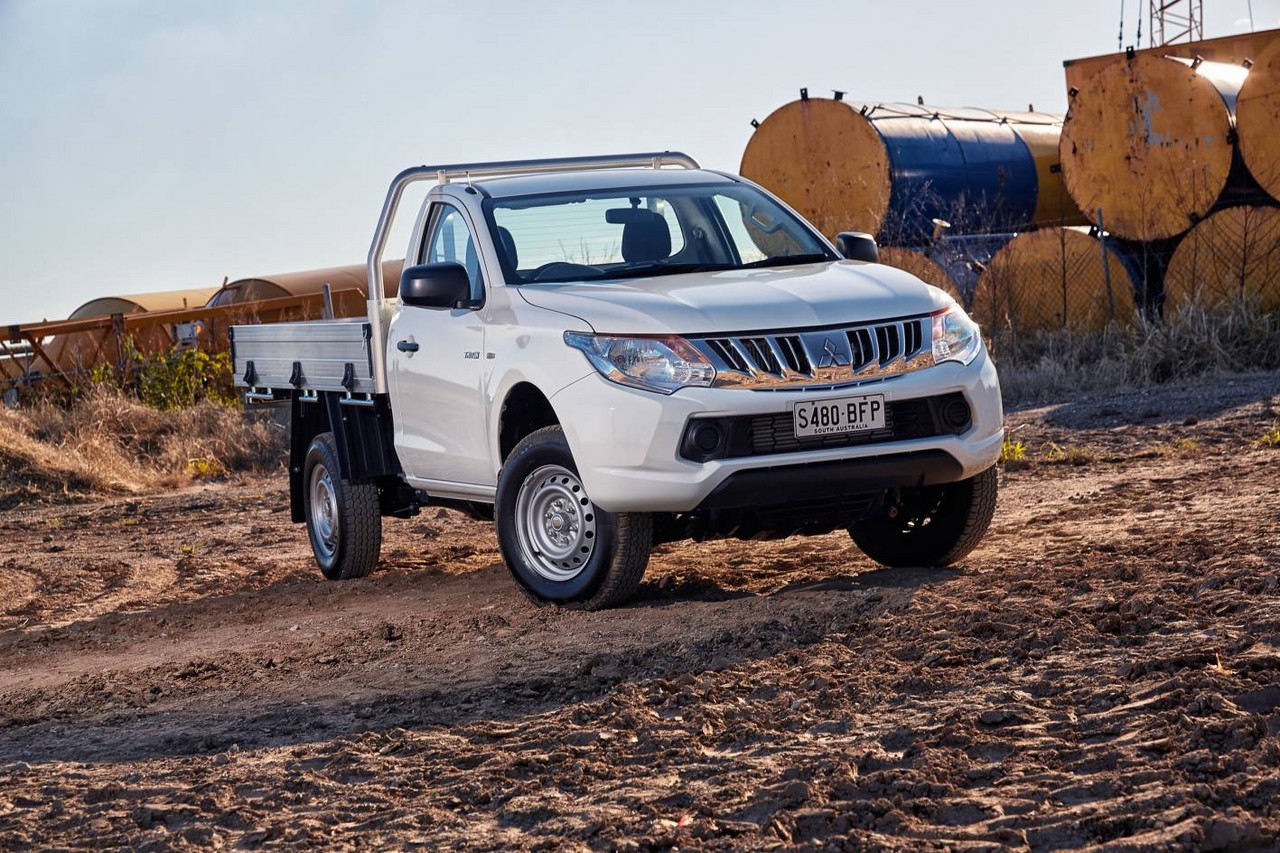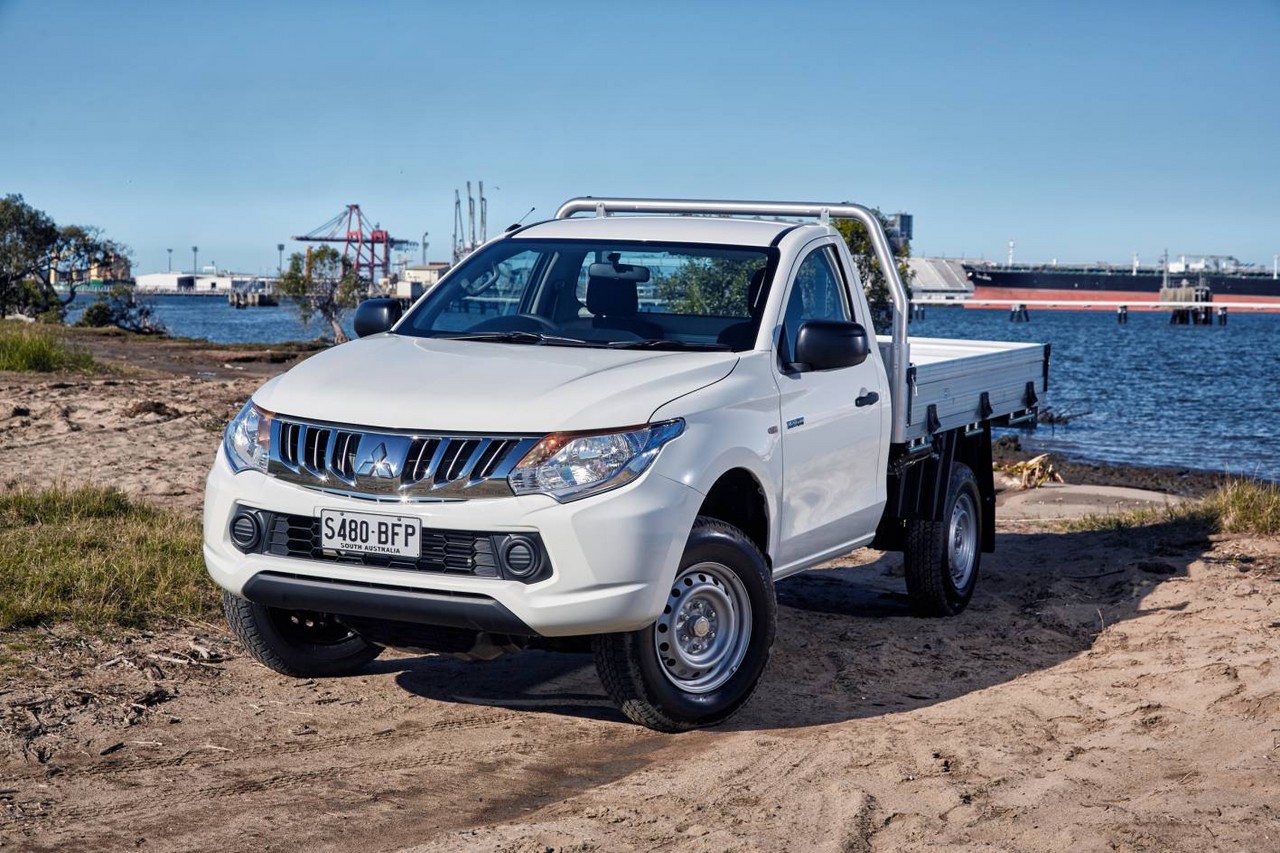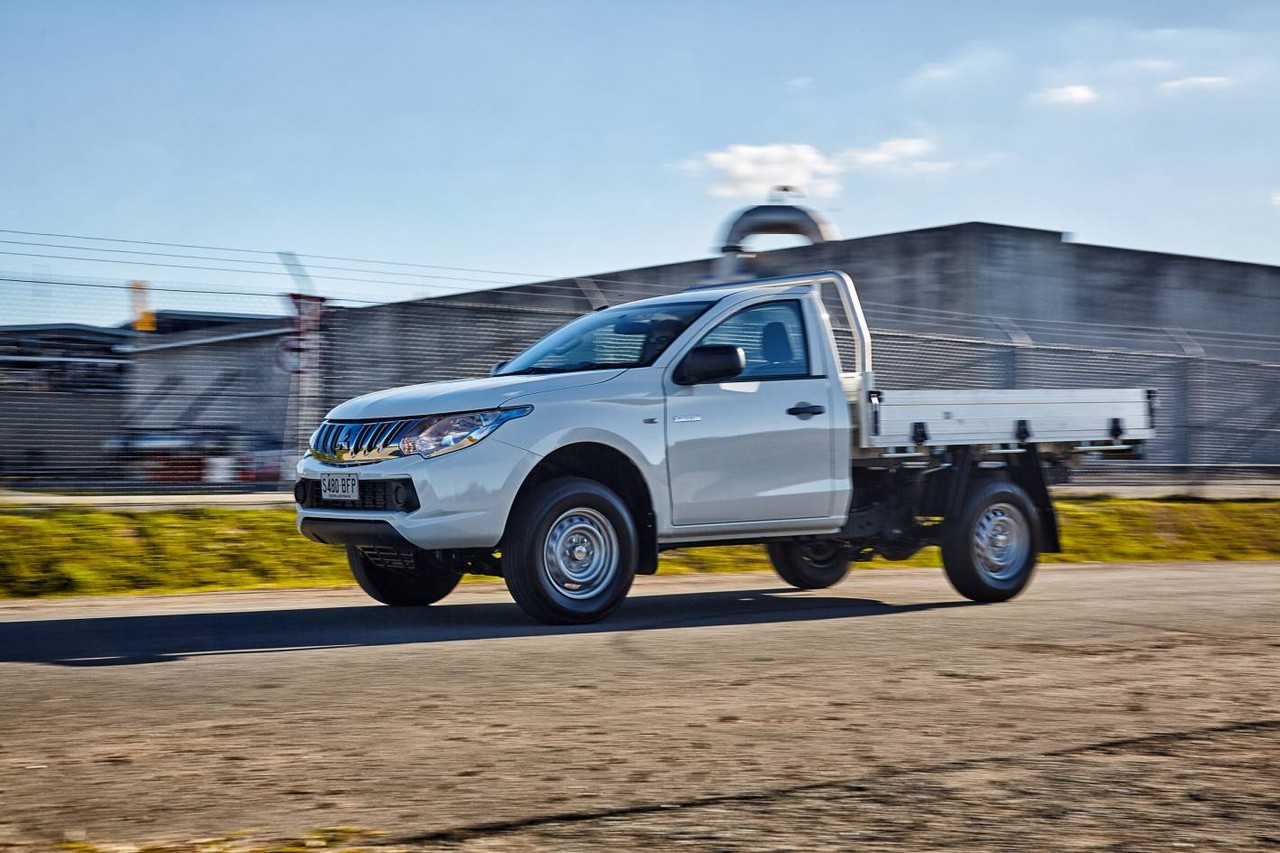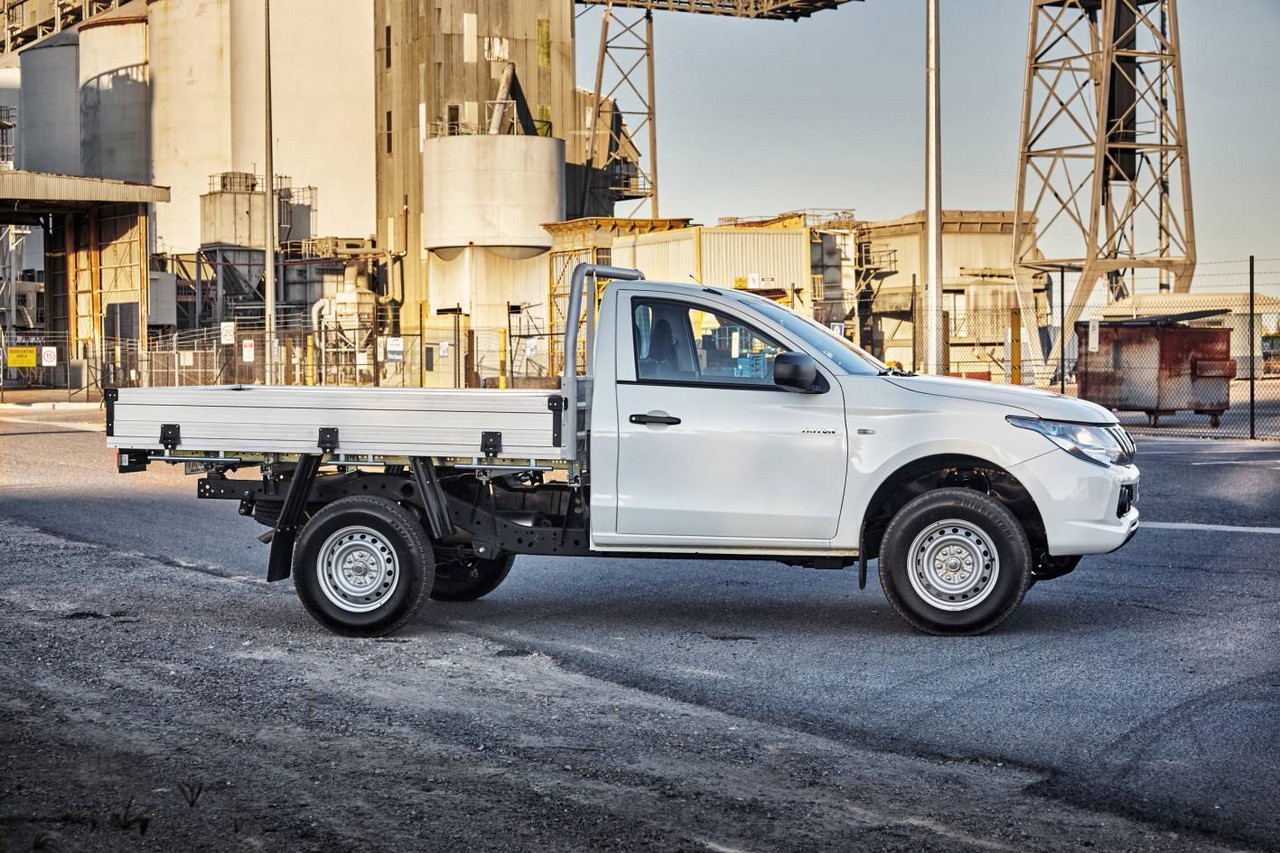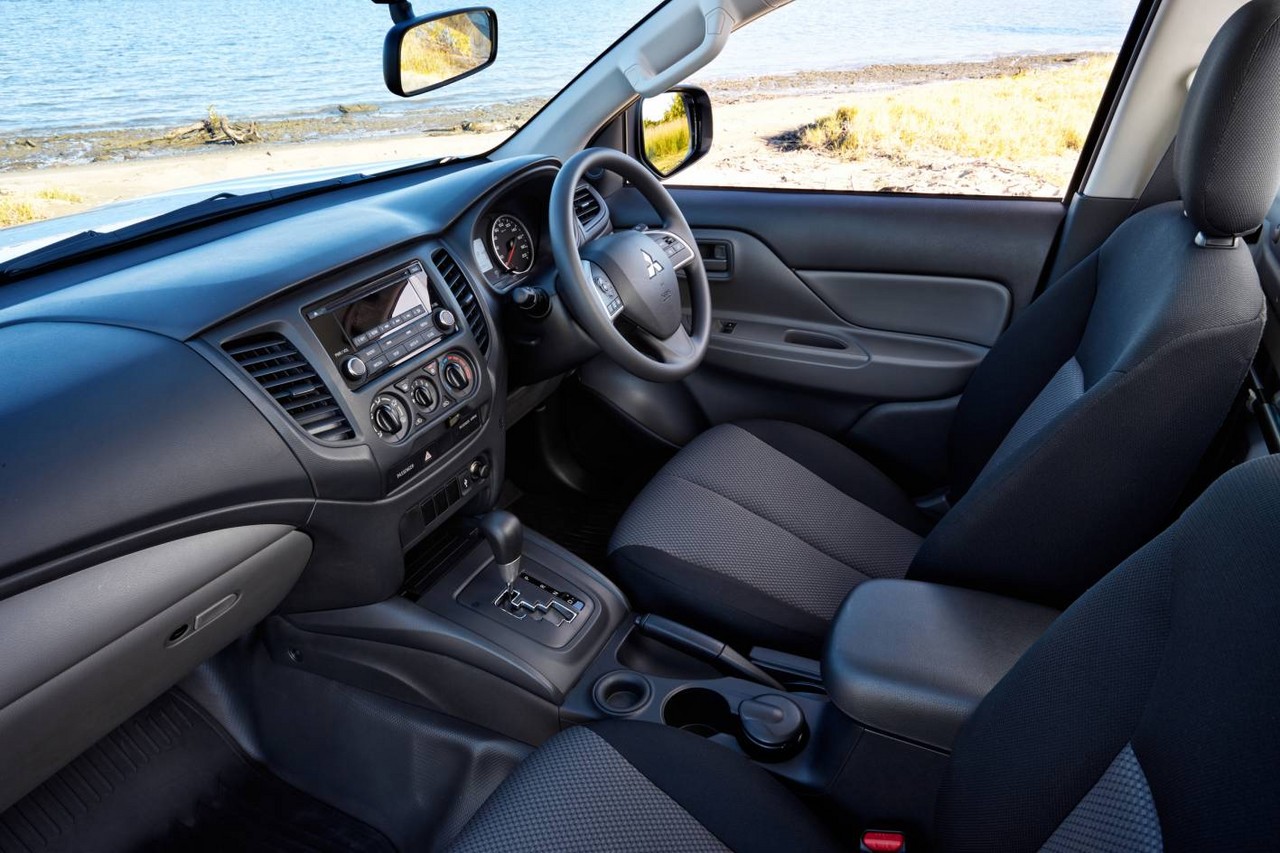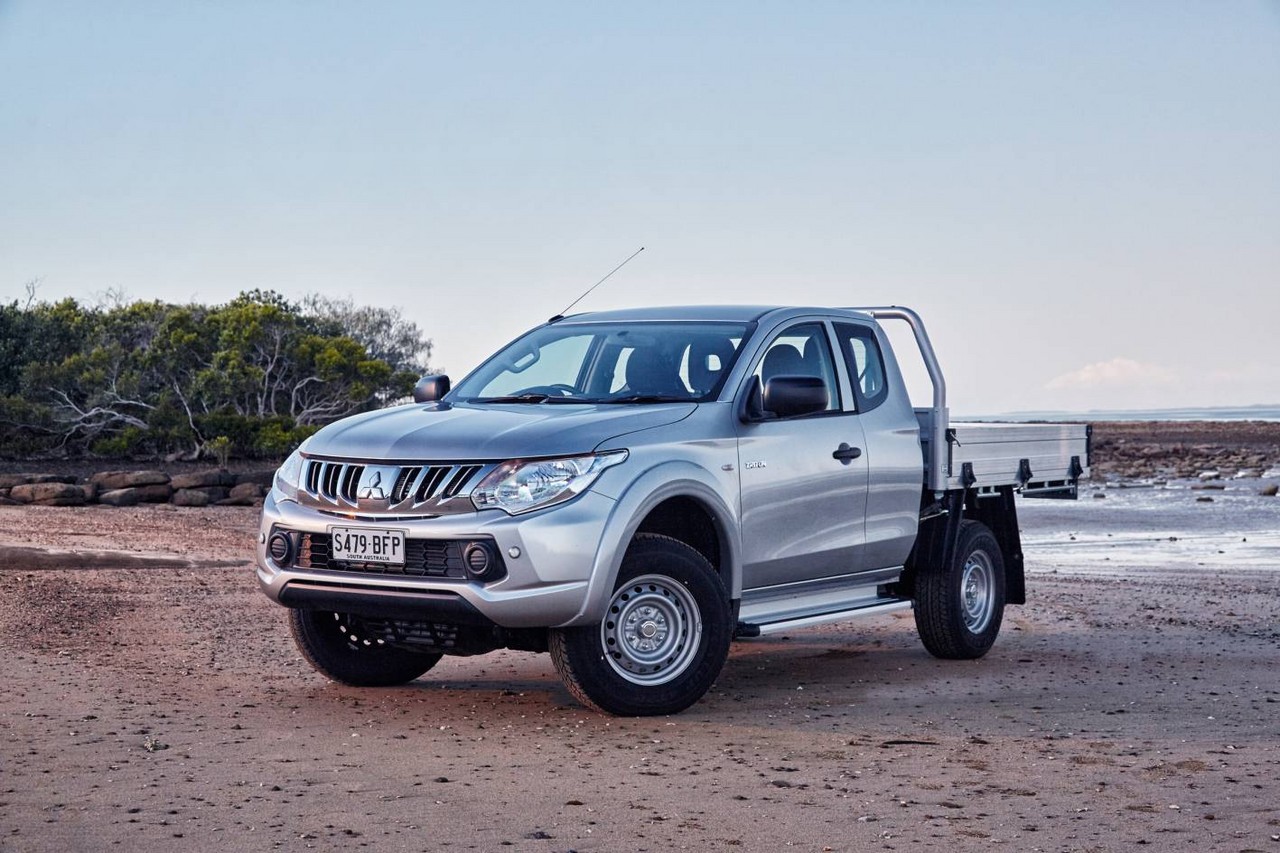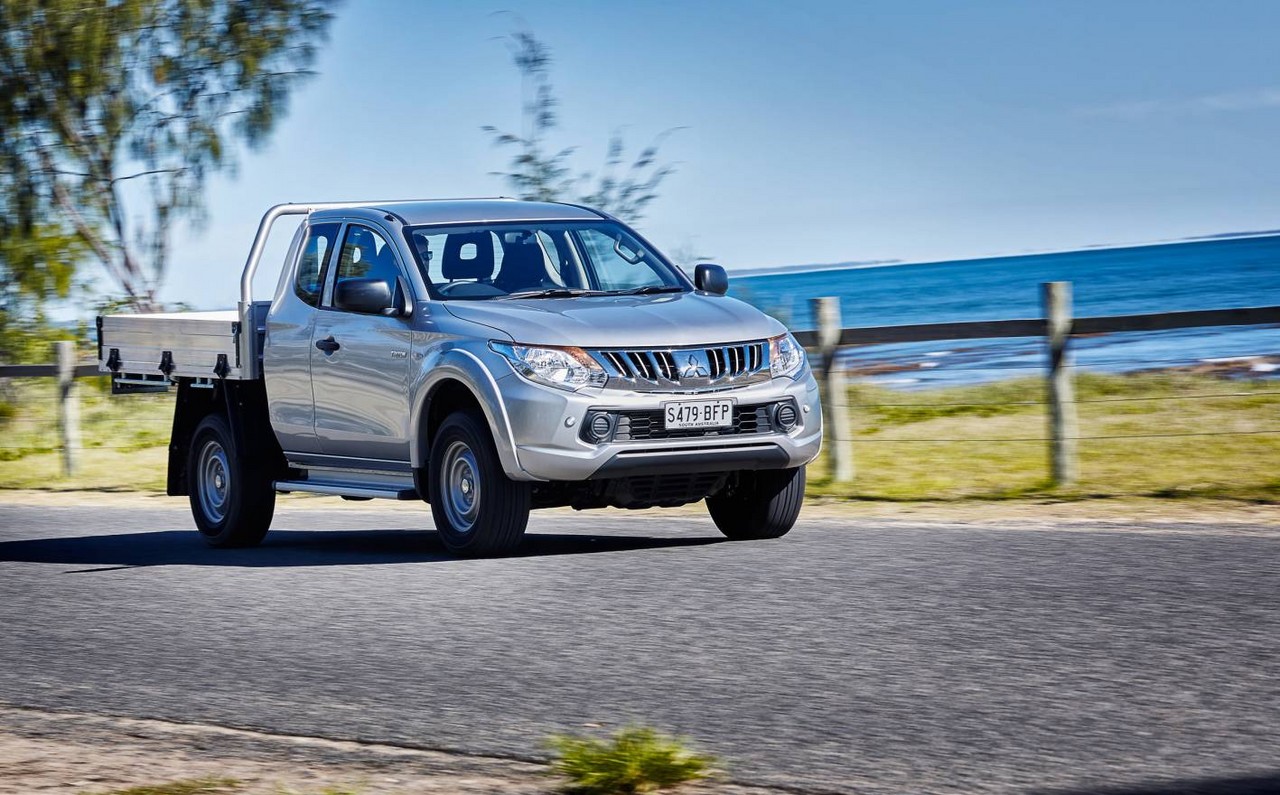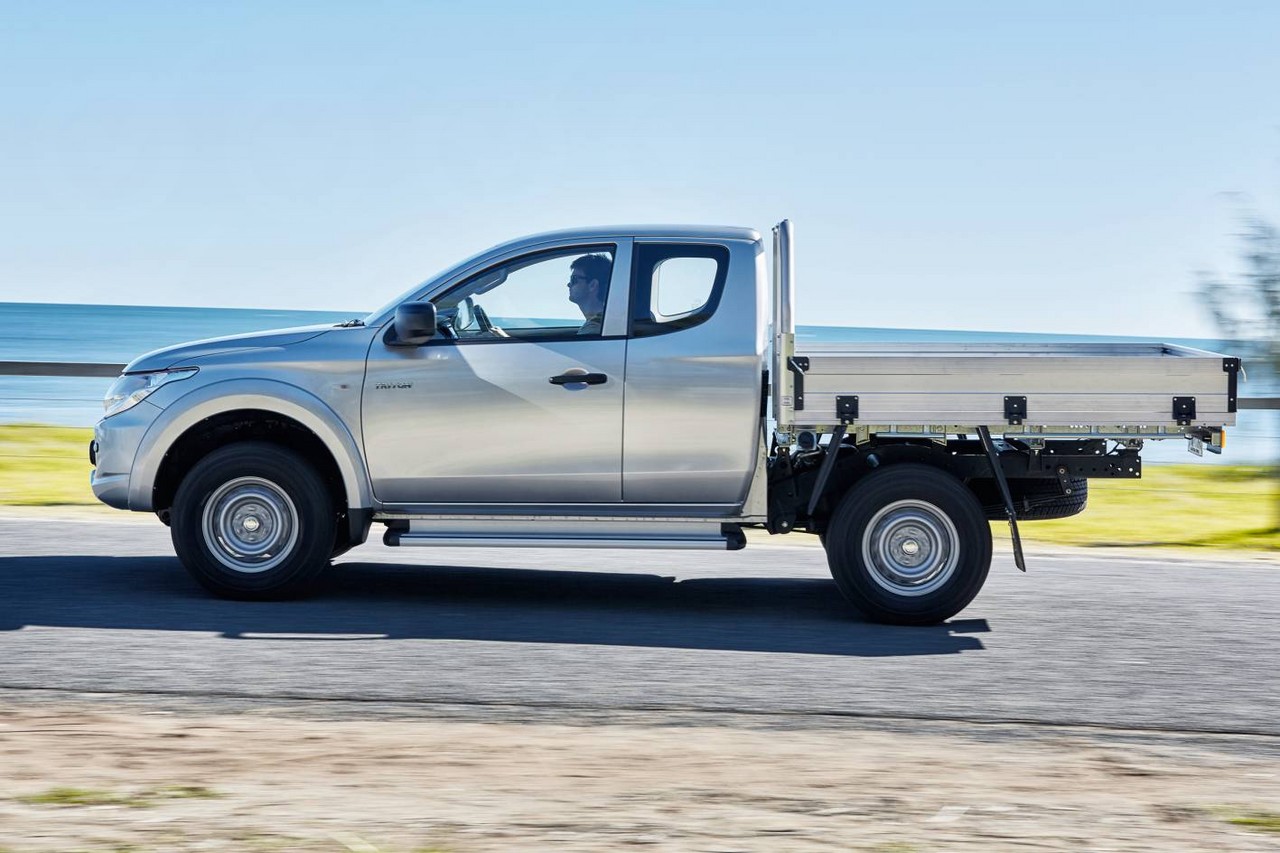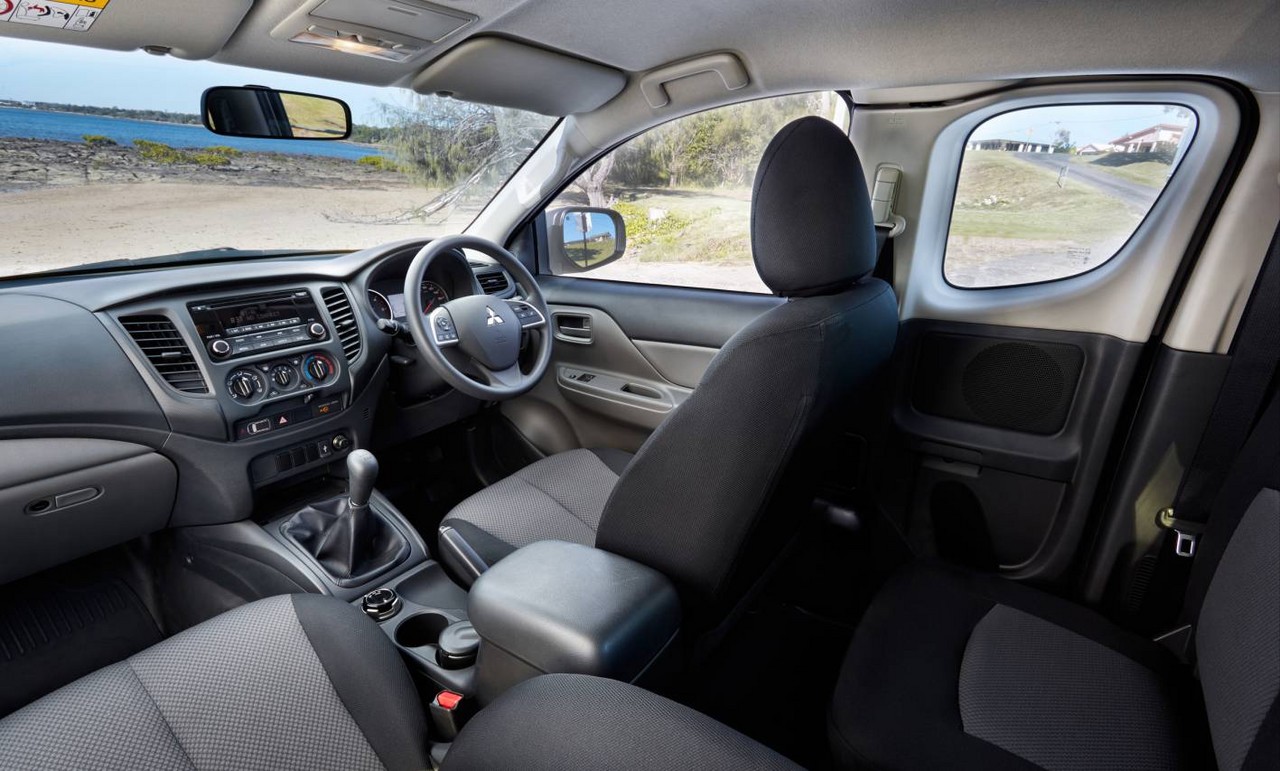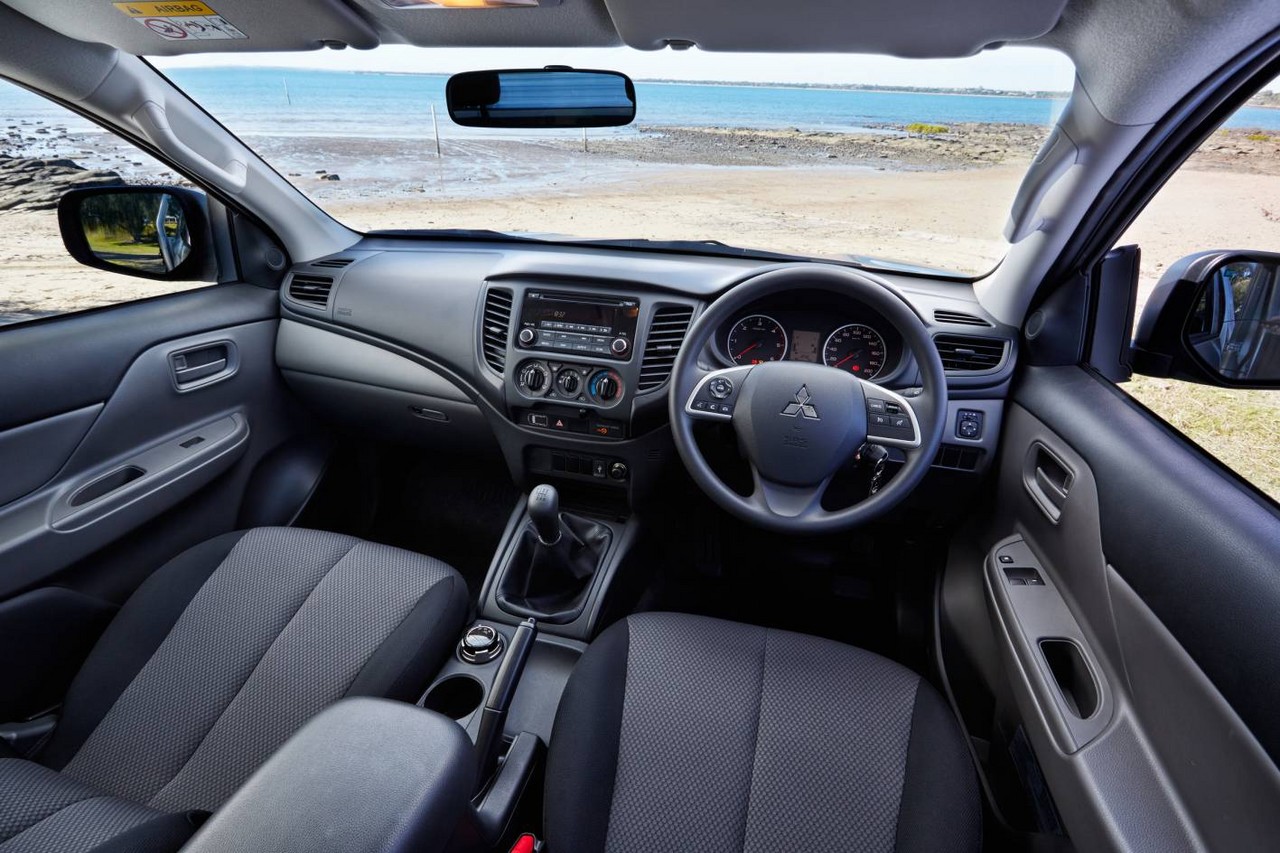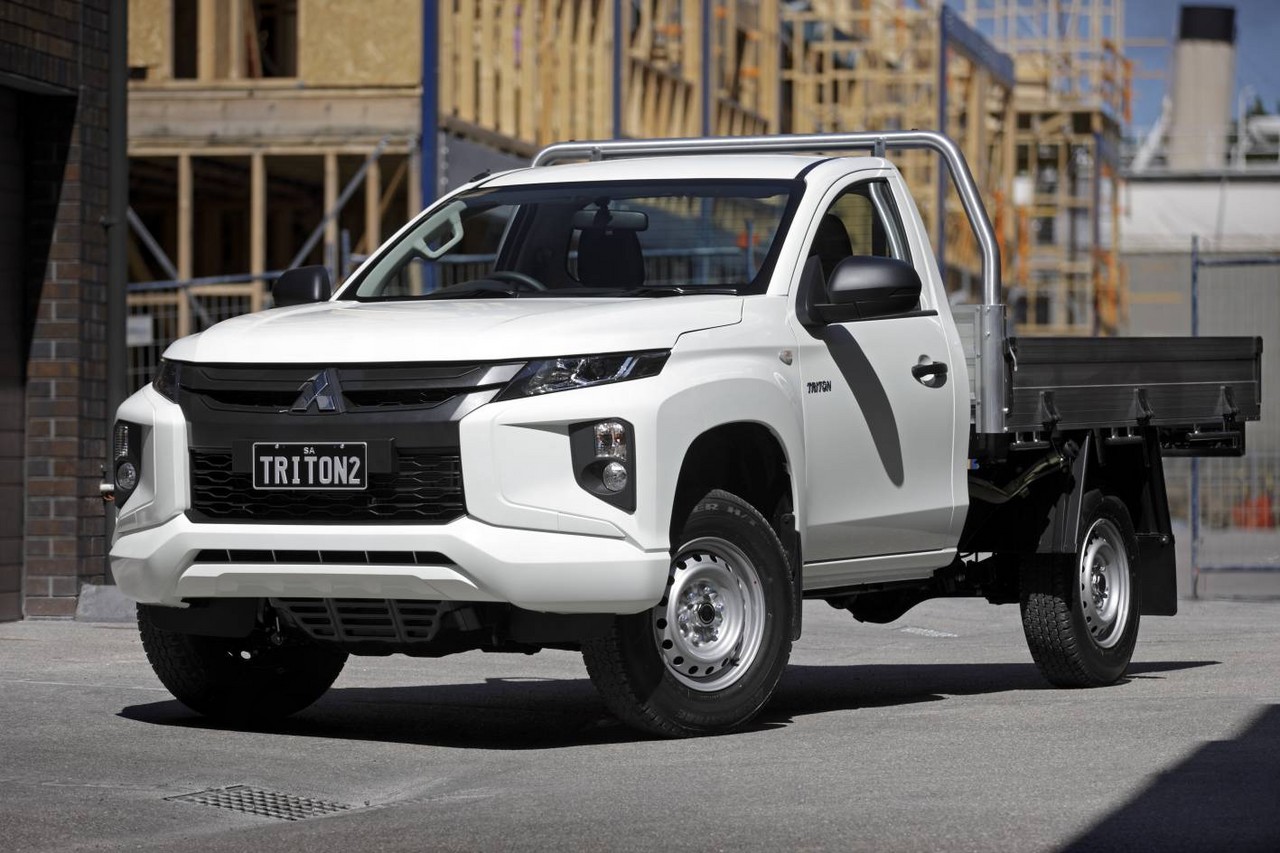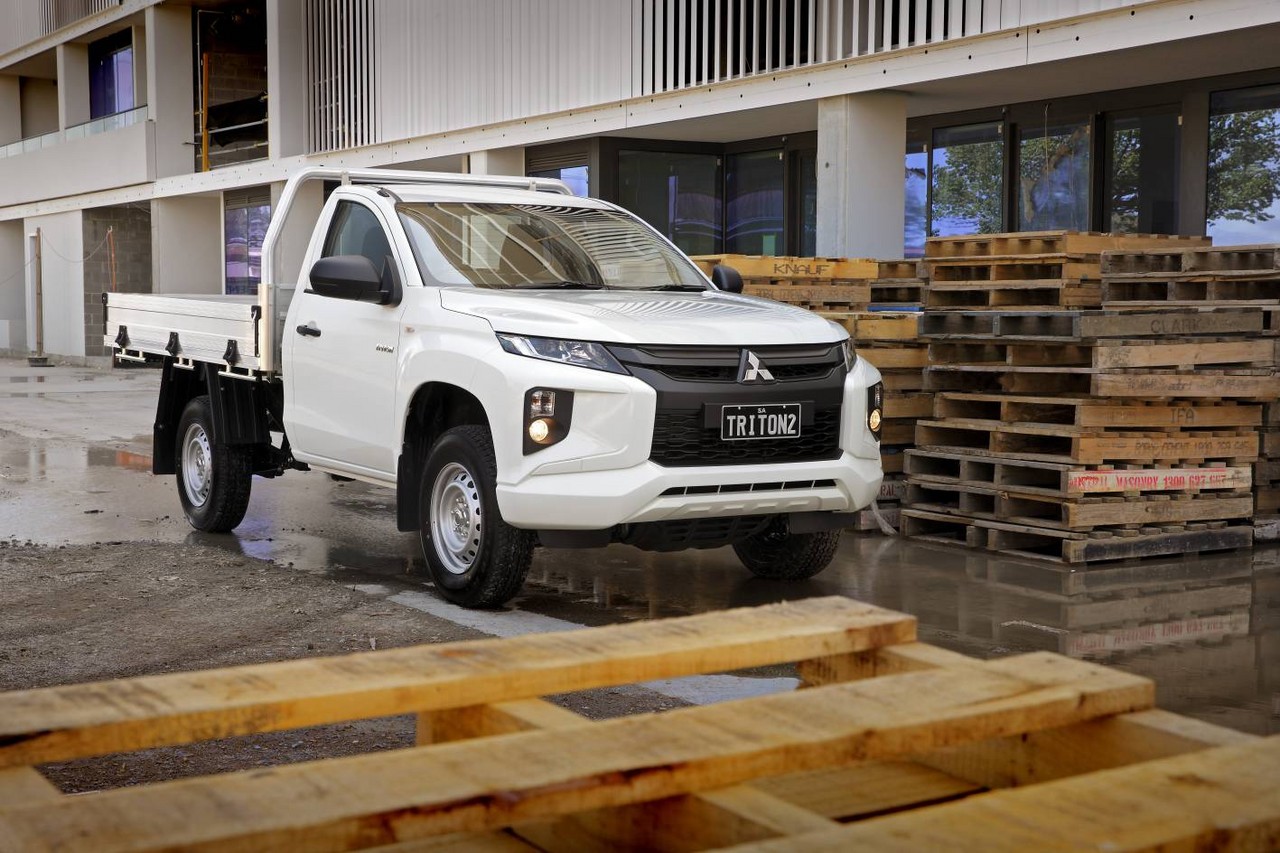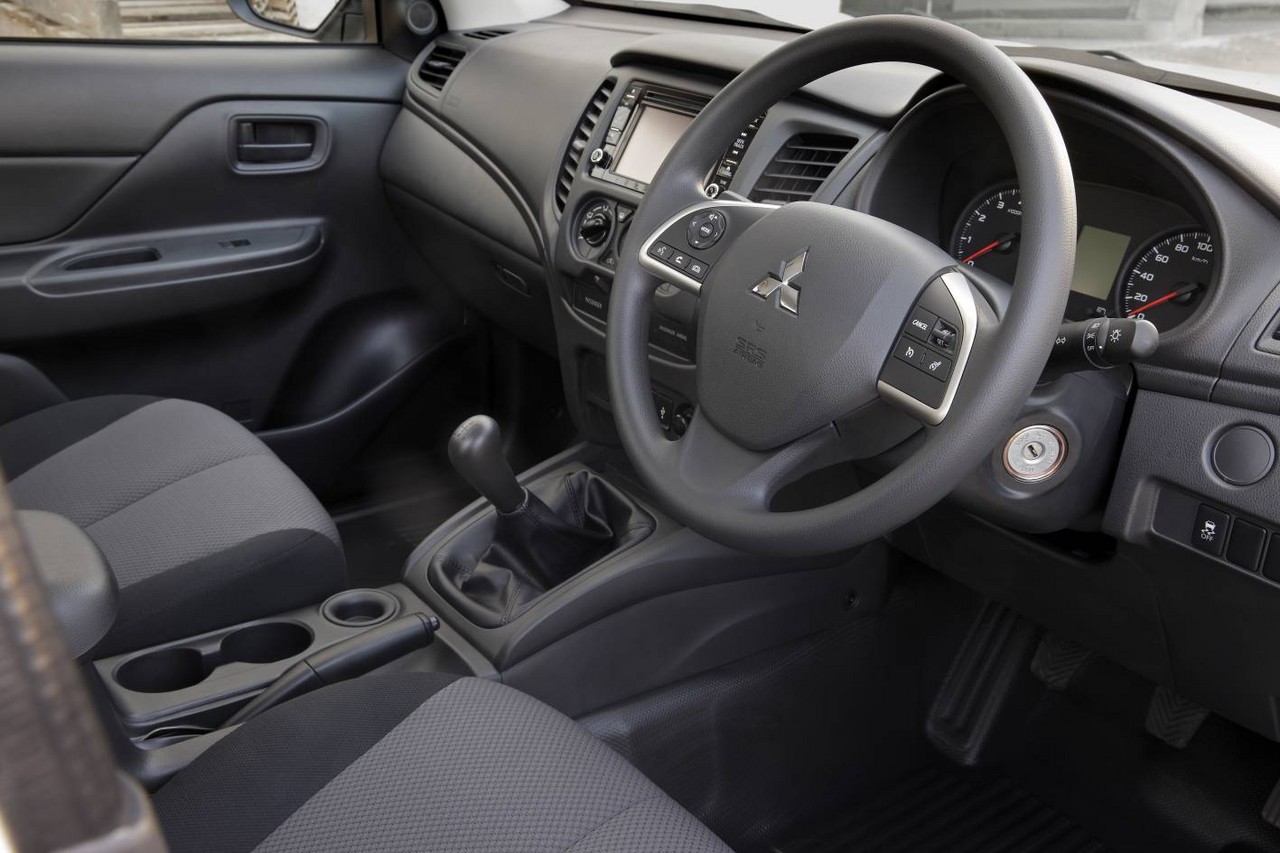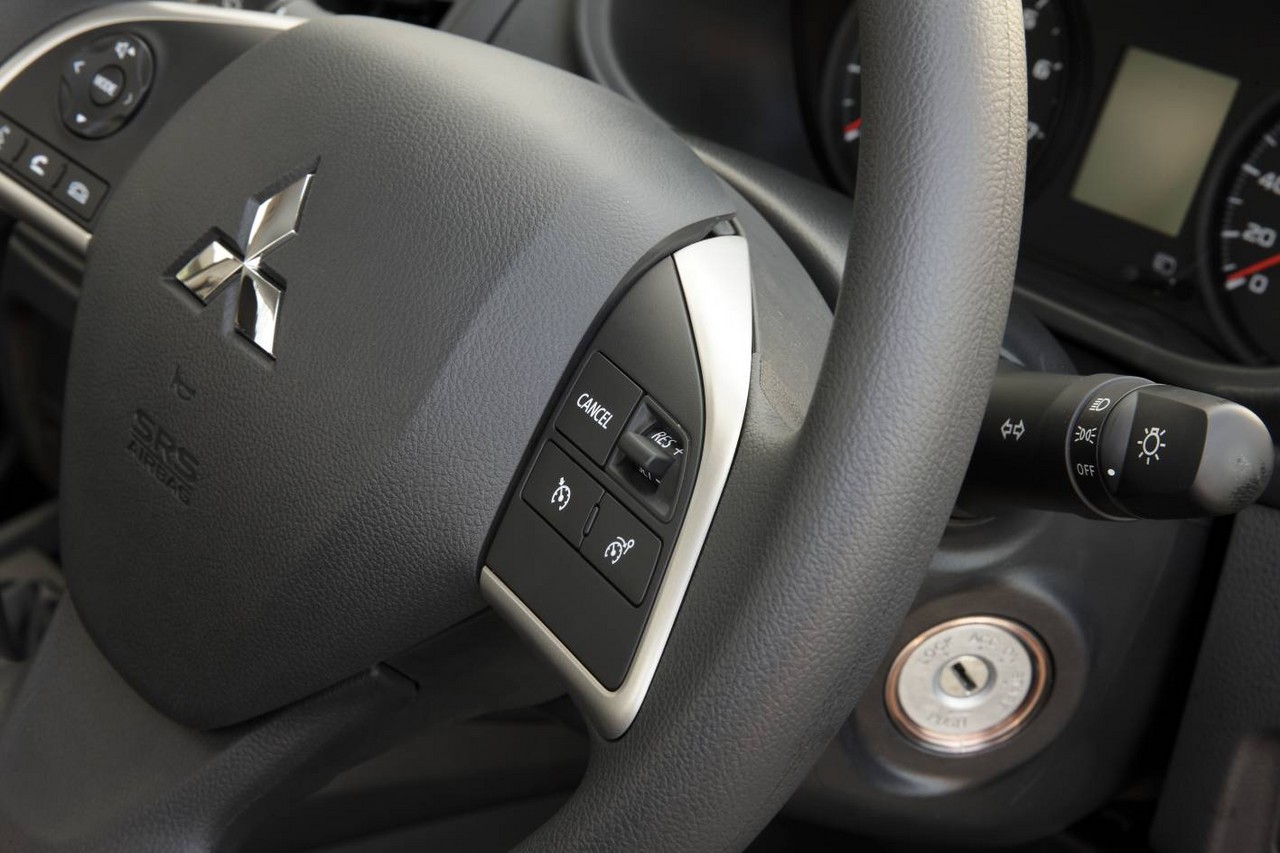
- Responsive and economical 2.4-litre turbo-diesel engine
- Quiet, well-insulated cabin
- Small turning circle
- Good ergonomics
- Firm, unsettled ride when unladen
- Reflections off chrome interior trim distract from door mirrors
- Limited interior storage
- For dual cabs, limited rear seat space
Mitsubishi MQ.I Triton Cab Chassis (2015-18)
Overview
Released in Australia in April 2015, the fifth generation Mitsubishi Triton cab chassis was available in single cab and club cab bodies. Manufactured at Mitsubishi’s Laem Chabang plant in Thailand, the Triton cab chassis was available in rear- or four-wheel drive models and powered by Mitsubishi’s 2.4-litre 4N15 turbo-diesel engine; transmission options consisted of five-speed automatic or six-speed manual models.
4N15 engine and transmissions
The newly developed 2.4-litre 4N15 turbo-diesel engine has a die-cast aluminium cylinder block and head, common-rail injection with piezo injectors, a variable geometry turbocharger, double overhead camshafts (with a maintenance-free timing chain), four valves per cylinder, a compression ratio of 15.5:1 and diesel particulate filter (DPF). The 4N15 engine also has Mitsubishi’s ‘MIVEC’ system which provides two-step control of intake valve timing and lift.
Of the transmissions,
- the six-speed manual transmission had triple-cone synchromesh on the first, second and third gears, as well as a dual mass flywheel to reduce engine vibration; and,
- the five-speed Aisin automatic transmission had a gate-type shift pattern and ‘Sport Mode’ for sequential shifting.
| Body | Variant | Engine | Drive | Trans. | Peak power | Peak torque |
|---|---|---|---|---|---|---|
| Single cab | GLX | 2.4-litre turbo-diesel I4 | RWD | 5sp auto, 6sp man. |
133 kW at 3500 rpm | 430 Nm at 2500 rpm |
| 4×4 | 6sp man. | |||||
| Club cab | GLX | 2.4-litre turbo-diesel I4 | 4×4 | 6sp man. | 133 kW at 3500 rpm | 430 Nm at 2500 rpm |
4WD system
The Triton GLX was fitted with Mitsubishi’s ‘Easy Select’ 4WD system which, via a four-wheel drive selector dial, enabled the driver to select from the following drive modes –
- 2H: rear-wheel drive with high range gears;
- 4H: four-wheel drive with high range gears; and,
- 4L: four-wheel drive with low range gears. For the 2015 Triton, the sub-transmission used low gearing for improved all-terrain performance in 4L.
Furthermore, the driver could switch between 2H and 4H while driving at speeds of up to 100 km/h.
Body and dimensions
According to Mitsubishi, the fifth generation Triton has a more rigid chassis frame and cab, with torsional rigidity in the chassis frame increasing by 7 per cent compared to its MN Triton cab chassis predecessor. Furthermore, the Club Cab models had new double-hinge doors which provided improved access to the area behind the front seats.
The Triton single cab was 1785 mm wide, 1765 mm tall (1770 mm for 4×4 models) and had a 3000 mm long wheelbase; overall length depended on the rear tray; the Triton club cab was 1780 mm tall.
Suspension
The 2015 Triton had double wishbone front suspension and leaf spring rear suspension. Relative to its predecessor, however, changes included:
- an upgraded front stabiliser bar;
- revised spring rates;
- optimised shock absorber characteristics;
- a bush-type stab bar lower link for the front suspension; and,
- for the rear leaf springs, mounting position and length were extended by 120 mm.
Safety equipment
Standard safety equipment for the 2015 Triton cab chassis included dual front airbags, a driver’s knee airbag, front seat-mounted side airbags, full-length curtain airbags, ABS, electronic brake force distribution, brake assist, electronic stability control (including trailer stability assist), traction control and front seatbelts with pretensioners and load limiters.
ANCAP crash testing
In ANCAP crash testing , the 2015 Triton dual cab received a five star adult occupant protection rating with a score of 36.22 out of 37. In the frontal offset crash test, occupant protection was generally rated as good, though protection of the driver’s chest and lower legs was rated as acceptable (i.e. a slight risk of serious injury). For the side impact and pole tests, maximum points were awarded.
Features: Triton GLX cab chassis
Standard features for the Triton GLX cab chassis included a two speaker sound system with a radio and CD player, USB port, Bluetooth mobile phone connectivity and audio streaming with voice control, air conditioning, front bucket seats, cloth seat trim, cruise control, halogen headlights, remote central locking, power mirrors, front power windows, tilt and telescopic steering wheel adjustment, a height adjustable driver’s seat, trip computer, an alarm and immobiliser.
While rear-wheel drive Triton single cab models were fitted with 16 x 6.0 J steel wheels and 205 R16C 110/108R 8PR tyres, Triton 4×4 models had 16 x 7.0J steel wheels with 245/70 R16 111S RF tyres . Triton GLX club cab models were also fitted with side steps.
December 2016 update
In December 2016, the following changes were introduced for the Mitsubishi Triton cab chassis range:
- The Triton GLX was equipped with a six speaker sound system with digital radio tuner (DAB) and 6.1-inch colour touch screen. An automatic, speed-sensing door lock was also introduced as standard across the range; and,
- Mitsubishi Triton GLX 4×4 and GLX+ 4×4 variants were also fitted with all-terrain tyres for greater off-road ability.
Paint colours
The Triton was available in the following paint finishes:
- White;
- Black pearl;
- Red;
- Sterling Silver metallic;
- Titanium Grey metallic;
- Impulse Blue metallic; and,
- Earth Green metallic.
Specifications
Mitsubishi MQ.II Triton Cab Chassis (2018-on)
Overview
Production of the Mitsubishi MQ.II Triton cab chassis commenced in November 2018 and it was released in Australia in January 2019. The full range is given in the table below.
Changes for MQ.II Triton
Visually, the MQ.II Triton could be identified by its new front mask which was based on Mitsubishi’s ‘Dynamic Shield Concept’. As part of this, the bonnet line was raised, the fog lamps repositioned and larger chrome elements were utilised. Inside, the MQ.II Triton introduced a monotone colour scheme, soft-touch materials and stitching for contact areas and, for door trims, thicker-gauge laminate and stitching.
Other changes for the MQ.II Triton included:
- Reinforcements to increase rigidity in the engine compartment surrounds and in the chassis frame, cab and cargo bed joins;
- Larger-capacity rear dampers to improve ride comfort; and,
- Changes to the rear leaf springs to improve comfort on paved surfaces and directional stability on unmade roads.
| Body | Engine | Drive | Variant | Trans. | Peak power | Peak torque |
|---|---|---|---|---|---|---|
| Single cab | 2351 cc 4G64 petrol I4 | 4×2 | GLX | 5sp man. | 94 kW at 5250 rpm | 194 Nm at 4000 rpm |
| 2442 cc 4N15 turbo diesel I4 | 4×2, 4×4 |
GLX | 6sp man., 6sp auto |
133 kW at 3500 rpm | 430 Nm at 2500 rpm | |
| Club cab | 2442 cc 4N15 turbo diesel I4 | 4×4 | GLX | 6sp man., 6sp auto |
133 kW at 3500 rpm | 430 Nm at 2500 rpm |
| GLX+ | 6sp auto | |||||
| Dual cab | 2442 cc 4N15 turbo diesel I4 | 4×4 | GLX | 6sp man. | 133 kW at 3500 rpm | 430 Nm at 2500 rpm |
| GLX ADAS | 6sp auto |
Safety equipment
For the Mitsubishi MQ.II Triton, safety equipment for the Triton GLX ADAS and GLX+ was extended to include:
- Front Collision Mitigation (FCM) with autonomous braking: used camera and laser radar systems to detect cars and pedestrians. When there was a risk of a collision, the driver would initially be warned by an audible alert. If the driver failed to respond, ‘firm’ braking would be applied automatically to reduce vehicle speed. If a collision was imminent, emergency braking would be applied to increase the rate of deceleration; and,
- Lane Departure Warning (LDW): used the forward-facing camera to detect lane markings. If the Triton drifted out of its lane without the indicators having been applied, then an audible alert would sound and a warning would be displayed in the multi-function display.
Features: Mitsubishi Triton GLX
The Triton GLX and GLX ADAS were equipped with Mitsubishi’s ‘Display Audio’ system which had a 6.1-inch touchscreen, CD player, USB input, Bluetooth mobile phone connectivity with voice control and audio streaming; single cab models had a two speaker audio system, though club cab and dual cab models had a four speaker system.
Beyond this, standard features for the Mitsubishi Triton GLX included cruise control, halogen headlights and daytime running lights, remote central locking, power mirrors, power windows, tilt and telescopic steering wheel adjustment, two 12 volt power sockets, vinyl floor covering, a trip computer and an immobiliser.
Features: Mitsubishi Triton GLX ADAS
Compared to the Triton GLX, the Triton GLX ADAS added dusk-sensing headlights, rain-sensing wipers and an electrochromatic rear view mirror.
Features: Mitsubishi Triton GLX+
The Triton GLX+ was equipped with Mitsubisih’s ‘Smartphoen link Display Audio’ system which had a 7.0-inch touchscreen, digital radio tuner (DAB), two USB inputs, an HDMI input, Android Auto and Apple CarPlay, though omitted the CD player of the ‘Display Audio’ system. Additional features for the Triton GLX+ included 16-inch alloy wheels, climate control air conditioning and side steps.
October 2019 update (‘MY20’)
The ‘2020 model year’ Mitsubishi MQ.II Triton was released in Australia in October 2019. As part of this update,
- Triton GLX+ variants could be specified with a rear differential lock;
- The Triton GLX+ 4×4 was equipped with Mitsubishi’s ‘Easy-Select 4WD’ for easy switching between 2WD and 4WD modes; it also included 2H, 4H and 4L transfer case settings; and,
- Dual cab Triton GLX+ variants were fitted with a rear air circulator.
Specifications and brochure
Related links
